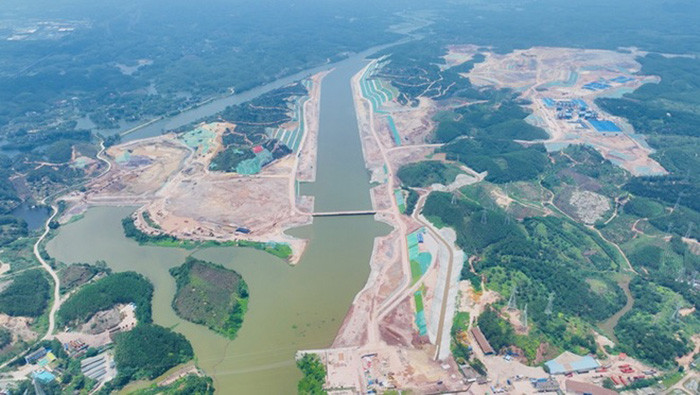China has built its first major canal in 700 years.

Aerial photo of the Pinglu Canal construction site
The 135-km Pinglu Canal, which cost 72.7 billion yuan ($10.1 billion), has been under construction in the Guangxi Zhuang Autonomous Region since May.
The South China Morning Post (Hong Kong, China) reported on July 24 that Beijing hopes the canal can help facilitate trade with Southeast Asian countries.
Chinese authorities have long favored building bridges and roads to connect and facilitate the movement of people and goods. Meanwhile, building canals requires a large and technically proficient workforce.
Over 2,200 years ago during the Qin Dynasty, China’s first emperor, Qin Shi Huang, built the 36.4-kilometer-long Lingqu Canal to send troops to fight tribes in the south and expand the country’s territory. Qin Shi Huang’s “huge” project connected the Xiang River in Hunan Province and the Li River in the Guangxi Zhuang Autonomous Region.
In addition, a 1,800 km canal connecting Beijing and Hangzhou was completed 700 years ago during the Yuan Dynasty (1279-1368). Thus, when completed, Pinglu will become China's first canal in 700 years.
Currently, goods from western China to Guangzhou and Hong Kong travel via the Xi and Pearl Rivers, but once the Pinglu Canal is completed, the journey from western China to the sea will be shortened by more than 560 kilometers. According to official estimates, the canal can accommodate ships with a capacity of up to 5,000 tons. The Pinglu Canal will mainly be used to transport coal, minerals, cement, grain, construction materials and containers.
The Pinglu Canal is not only seen as an opportunity to develop Guangxi Province, but also demonstrates China's advanced construction techniques and strategic thinking in a rapidly changing geopolitical context.
“The practical value of this project is very promising. This is equivalent to more ‘capillaries’ to closely connect the Chinese market and the Association of Southeast Asian Nations,” said Gao Zhendong, a veteran consultant who helps Chinese companies find investment opportunities in Southeast Asia.
The canal is expected to facilitate container ships or cargo ships leaving Nanning - the capital of Guangxi Zhuang Autonomous Region - to Vietnam, Malaysia, Singapore, Indonesia and other Southeast Asian countries within a few weeks.
During a meeting with ASEAN foreign ministers in Jakarta, Indonesia, earlier this month, Director of the Office of the Foreign Affairs Commission of the Communist Party of China Central Committee Wang Yi called for comprehensive cooperation to deepen the bilateral strategic partnership.
Huang Yonghui, a senior adviser to the Guangxi Development and Reform Commission, said that China needs a denser logistics network to ensure bilateral supply chains and closer economic and trade exchanges. The Pinglu Canal is expected to improve bilateral infrastructure connectivity, paving the way for Guangxi to have comprehensive links with Southeast Asian markets via roads, railways, shipping and aviation.
Infrastructure connectivity is considered one of the top priorities, as reflected in Beijing's Belt and Road Initiative and the Beijing-headquartered Asian Infrastructure Investment Bank (AIIB), the South China Morning Post reported.
Apart from China, many other countries have also attempted to shape their national strategic development by building canals. The Suez Canal in Egypt and the Panama Canal, which connects the Atlantic Ocean to the Pacific Ocean, have played an important role in geopolitics over the years. There is also the 120 km Thai (or Kra Isthmus) Canal project connecting the Gulf of Thailand and the Andaman Sea, which has been discussed for decades since the early 2000s but has yet to be implemented. Meanwhile, China is trying to achieve its plan to complete the Pinglu Canal by 2026.
Chinese scientists are also conducting mathematical and physical simulations to predict how seawater will affect the relocation and adjustment of local drinking water sources and irrigation sites after the canal is put into operation.
The environmental impact assessment report for the canal said it would pass through five drinking water protection areas, cover 849.18 hectares of agricultural land, 16.56 hectares of non-commercial forest and 13.9 hectares of wild mangrove forest, and impact aquatic ecosystems. The regional environmental watchdog said it would protect the ecosystem as it developed the canal, without elaborating.
According to Tin Tuc Newspaper